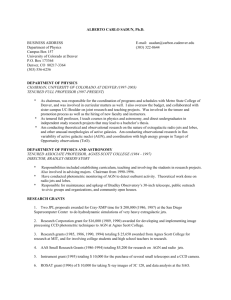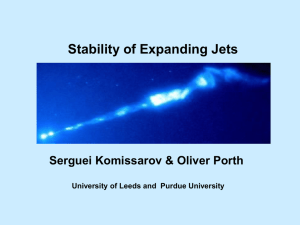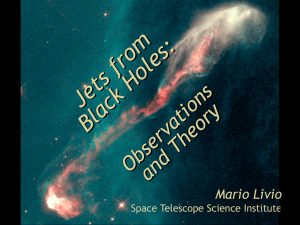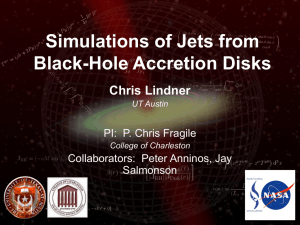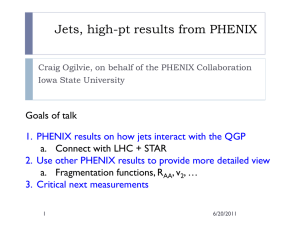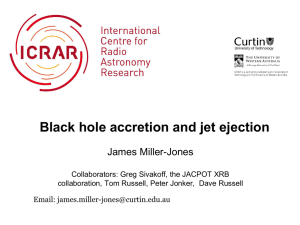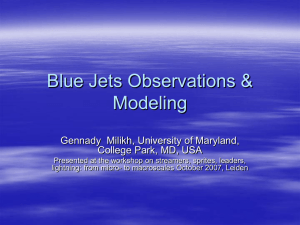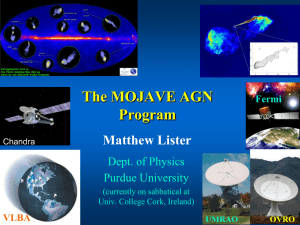Jets from stellar tidal disruptions by supermassive black - ICC-UB
advertisement
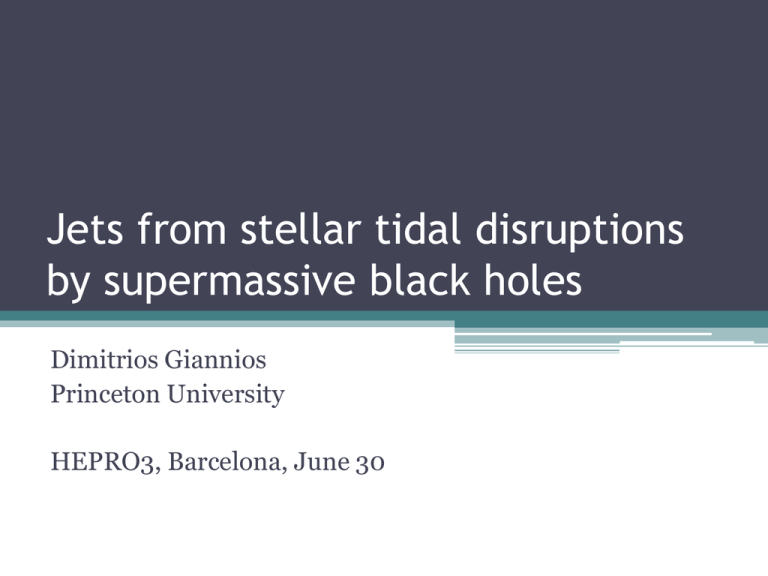
Jets from stellar tidal disruptions by supermassive black holes Dimitrios Giannios Princeton University HEPRO3, Barcelona, June 30 Galactic centers: some are active, most are dormant NGC 3115 AGN Canada-France-Hawaii Telescope M87; NASA/Hubble Sgr A* starburst galaxies Ghez et al. 2005 Baldwin, Phillips & Terlevich 1981 Kormendy & Richstone 1995; Kauffmann et al. 2003 Rare glimpses to quiescent SMBHs from tidal disruption of a star When a wandering star finds itself within MBH 1/ 3 Rp Rt ~ R* M * it is tidally disrupted For solar type star Rt Rs 2GMBH , for MBH 108 M 2 c Rate of TDEs~10-4-10-5 yr-1gal-1 (e.g. Magorrian & Tremaine 1999) Rt (Rees 1988; Phinney 1989; Evans & Kochanek 1989) 1. Disruption 2. Fall-Back 3. Circularization and Accretion 5 / 3 M t * Ý M fallback ~ t fallback t fallback t fallback ~ days Figures Courtesy of Linda Strubbe Tidal Disruption of a Star by a Supermassive Black Hole Thermal “Flares” from Accretion Disk (Optical, UV, X-ray) (e.g. Rees 1988; Ulmer 1997; Ayal et al. 2000; Strubbe & Quataert 2009, 2010) Gezari et al. 2008 Galex D1-9 ~10 Candidate Detections So Far by - ROSAT All-Sky Survey (Komossa 2002) - XMM Slew Survey (Esquej et al. 2007) - Galex Deep Imaging (Gezari et al. 2009) - SDSS Stripe 82 (van Velzen et al. 2010) - PTF (Cenko et al. 2010) Where there is accretion to BH, there are jets! A substantial fraction of gravitational energy may be channeled into relativistic jets Non-thermal signatures from TDEs M87; NASA/Hubble jets in galactic centers stellar binaries gamma-ray bursts “Radio transients from Stellar Tidal Disruptions by Massive Black Holes” Giannios & Metzger 2011 jet ~ 0.1 jets? jet ~ 10 jets? Ýfallback M ÝEdd M ÝEdd 0.03M t energy released E rel ~ 0.1Maccc 2 ~ 1053 erg jet erg energy in jets E jet ~ jet E rel ~ 10 51 0.01 Supernova or GRB! Radio Transients by Stellar Tidal Disruptions by Massive Black Holes Jet Interaction with ISM Prediction: radio synchrotron emission peaking at tpeak ~ 1 – a few years: syn e 2 B 1/ 2 n ism 1/ 2 ~ 25 GHz 0.1 0.01 10cm-3 F syn j B 1/ 2 jet 1 D 2 ~ 2 m Jy 0.010.01 10 1Gpc Blind radio surveys may detect tens of TDEs per year Giannios & Metzger 2011 And then came the … Event GRB 110328A/Swift 1644+57 (Levan et al. 2011; Bloom, Giannios et al. 2011; Burrows et al. 2011) • Triggered Swift BAT on March 28, 2011 /X-ray • Triggered BAT 3 more times over next few days • Remains bright in X-rays • IR and Radio Brightening IR-Optical • Host galaxy at z = 0.35 • NOT a (normal) GRB - duration ~ months •NOT a normal AGN - no evidence for AGN or past activity Radio Levan et al. 2011 - low luminosity Compact Host Galaxy at z = 0.35 Levan et al. 2011 SMBH origin • ~100 s variability and 7 bulge mass Mb < 1010 M MBH< 10 M • LX > 1047 erg s-1 > 100 LEdd super-Edd accretion and/or beaming Levan et al. 2011 • Within < 150 pc of galactic center Not an AGN “Mini Blazar” Hypothesis Bloom, Giannios et al. 2011; see also Burrows et al. 2011, … radio t ~ 3 days X-rays • synchrotron self-absorption Rradio > 1016 cm vej ~ c external shock from ISM interaction (Giannios & Metzger 2011) • X-ray variability RX ~ c tX 2 ~ 3x1014 (/10)2 cm “internal” process (e.g. shocks, reconnection) jets from TDEs: (Rough) energetics and rates • observed (0.3-10) keV fluence Ex,iso~2x1053 erg ▫ ~ x3 for likely bolometric corrections ▫ ~ x2 for radiative efficiency of flow Ek,iso ~ 1054 erg or Ek,true ~ 1051 erg depending on beaming • Rates very uncertain: 1 event in 7 years of Swift operation (Ωfov=4π/7 sr); observable out to z~0.4-0.8 Robs ~ 10-9 - 10-8 gal-1yr-1 or Rtrue ~ 10-6 – 10-5 gal-1yr-1 ~3-30% of ALL TDEs accompanied by powerful jets? Predictions Updated X-ray light curve • X-ray emission will continue to fade over the next few months (no later re-brightening/repetition) • If jet turns off, thermal disk emission may become visible (?) • GHz Radio emission will remain bright for ~ years • relativistic motion observable with VLBI (?) Implications Sw 1644+57 blazar • Detections: Future TDE detections with blind radio surveys IR/radio Giannios & Metzger 2011 • • Jet physics: B fields responsible for accelerating AGN jets can be generated in situ (e.g. via disk dynamo) TDE jets may accelerate UHECRs (Farrar & Gruzinov 2009), but production rate may be insufficient optical/UV/ X-ray
